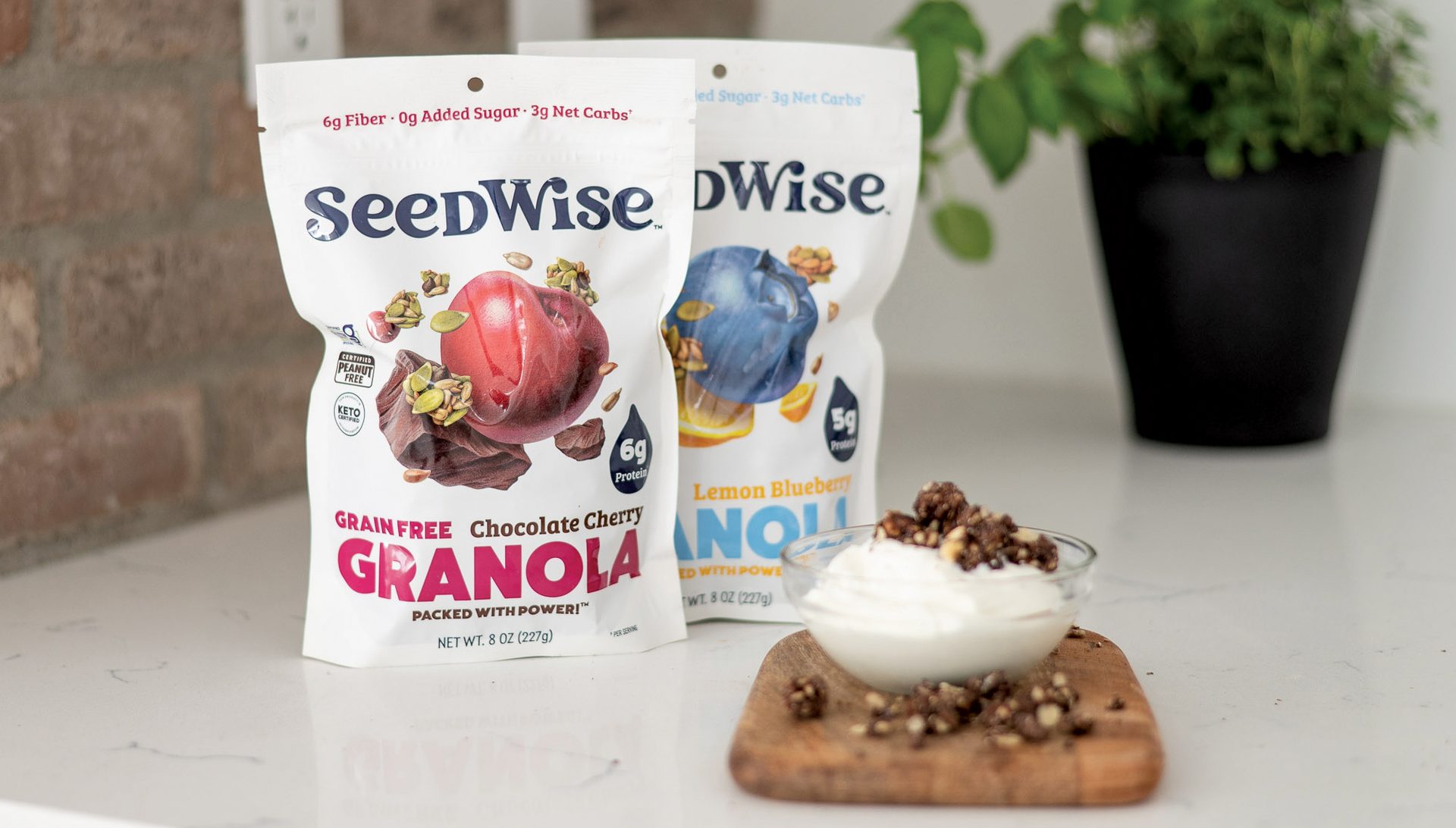JULY 2023

food allergens
Technologies
Intolerable Allergens
If it seems as if allergies and intolerances to certain ingredients have become more common, it’s because they are.
Nearly half of US adults avoid buying foods that contain known allergens. Video courtesy of Getty Images / Milan Jovic
According to multiple expert sources, roughly one in 10 Americans or more have either an allergy, sensitivity, or intolerance to a food. About a third of these sufferers have an allergy that is potentially life-threatening. This calls for greater caution than ever among product manufacturers.
What distinguishes these three conditions? An allergy is a response by your body’s immune system: think hives, rashes, or in a worst-case scenario, anaphylaxis. A food intolerance happens when your body fails to digest a food or an ingredient in food. Lactose intolerance is probably the most common.
By Keith Ayoob, EdD, Contributing Nutrition Editor

Over time, the body loses the ability to produce the enzyme (lactose) that digests the carbohydrate in dairy foods, causing bloating, gas, and sometimes diarrhea. Taking a lactase enzyme when you drink milk or eat dairy foods will usually prevent symptoms of lactose intolerance. A food sensitivity, on the other hand, can produce symptoms that are unrelated to food allergies or intolerances. It’s not well-understood, but people can report stomach pain, joint pain, or even light-headedness.
Fermented foods are all the rage, and that’s not going away. However, fermented foods aren’t exempt from causing allergic reactions, intolerances, or sensitivities. Foods such as kimchi, kefir, sauerkraut, and wine can help feed and grow a healthy gut environment. Yet approximately 10% of the US population reports hypersensitivity to wine. Many experts have singled out sulfites as being responsible for the reported reactions to wine, which range from headaches to sinus problems to hives, flushing, and asthma-like symptoms.
Sulfites are known to cause sensitivities, yet results of the study, “Allergic and intolerance reactions to wine,” published in 2018 in Allergologie Select, revealed that other components in wine could also be culprits, at least for some people. These included the grape proteins themselves; ingredients used in “fining” wines, such as fish gelatin, molds and yeasts; and even proteins from insects that contaminate the mash.
About 30 million Americans have fish or seafood allergies, but increasingly peerless analogs are allowing them to share in the seafood experience. Photo courtesy of: Gardein/Conagra Brands, Inc.
Food Allergies by the Number$
Allergy-friendly food are experiencing a 27% CAGR. Nearly half of US adults—85 million — do not purchase foods containing one of the top nine allergens because they or someone in their household has a food allergy. Instead, they spend more than $19 billion per year on specialty foods free of allergens.— Food Allergy Research & Education organization (FARE)

Eliminating the major allergens only excludes nine ingredients, making even a craveable granola possible for creative developers. Photo courtesy of: Ozery Family Bakery Corp.

On the other hand, fermentation can also hold promise for reducing food sensitivity. A 2020 study published in the journal Nutrients looked at the changes in cashew allergenicity during the fermenting of cashew “cheese.” Five different cashew cheeses, including analogs of brie and bleu, were studied, and from start-to-finish, reductions in allergen content ranged from 29% to 66%.
Someone with a true allergy to cashews would still need to avoid these cheese analogs, but these results suggest that those with milder sensitivities may have an option, especially if the fermentation process can advance to further reduce cashew allergen content. It should be noted, however, that the study did not take into consideration that the analogs used a different starter from the ones used in the classic versions which contain fungi from the Penicillium genus, itself a potential allergen.
The boom in allergen-free foods has been a boon to product makers focusing specifically on creating flavorful treats without the nine major allergens. Photo courtesy of: DeeBees Organics, Inc.
New Kids on the Chopping Block
Sesame was added to the list of major allergens after Congress passed the Food Allergy Safety, Treatment, Education, and Research (FASTER) Act of 2021. It joined the eight other major allergens for which labeling is required. Approximately 1.6 million Americans have a sesame allergy. About five times as many consumers are allergic to coconut, which caused it to be lumped in with tree nuts as an allergen even though botanically, coconut is a fruit.

Monosodium Glutamate (MSG) Sensitivity
In 1969, a physician published a letter to the editor of a medical journal in which he noted symptoms of headache, flushing, and light-headedness after eating Chinese food. He didn’t know the reason, so he suggested several possibilities. Monosodium glutamate—MSG—used in cooking was the only one that stuck.
The news immediately went “viral” and soon MSG was the subject of widespread scrutiny and anecdotal condemnation. A number of product manufacturers and restaurants stopped using it, and “No MSG” banners began appearing on restaurant menus and food labels.
The conundrum is that afteer more than 50 years of research, MSG sensitivity has not been sufficiently validated. In fact, except for a few studies with children, it has been disproven in numerous large, randomized, double-blind controlled studies.
Peanut and tree nut allergies affect kids the most, creating opportunities for chocolate candy makers who can boast an allergen-free facility. Photo courtesy of: Yummy Earth, Inc.
It’s difficult to connect the MSG sensitivity dots: MSG is made up of two components, sodium and glutamate. Sodium is present in most foods, and is far more common than MSG in the diet. Glutamate is an amino acid, a building block of protein. It is a “non-essential” amino acid because the body already makes its own glutamate in far greater amounts than is derived from the diet, albeit bound to its proteins. Many common foods are natural sources of glutamate, including mushrooms, tomatoes, and certain cheeses, yet sensitivities to them are uncommon.
Glutamate is poorly absorbed into the bloodstream. About 95% stays in the digestive tract, so much so that it is the most prevalent amino acid in the gut. It also is important for many of the gut’s metabolic and immune functions.
Eight is Not Enough
While there are more than 160 foods known to cause food allergies, according to the FDA, over 90% of food allergies can be attributed to nine foods: milk, eggs, fish shellfish, tree nuts, peanuts, wheat, sesame, and soybeans. Foods containing any of these nine allergens must state so on the food’s Nutrition Facts label. (The FDA added sesame in 2022 and since January 1, 2023, it has been required to be labeled as an allergen on packaged foods and dietary supplements.)
Fortunately, in recent years ingredient technologists have made impressive strides that reduce many of the differences between these ingredients and their conventional counterparts. Partnering with such ingredient specialists can be a great advantage for product developers and manufacturers.
Natural competitors
More organic products are hitting store shelves than ever before, and it is important to consider shifting consumer sentiment towards organic products.
So far, many consumers have demonstrated a willingness to pay the higher price point associated with organic products. Plus, as supplies of organic ingredients increase, prices decrease. Yet natural products have fewer restrictions and regulations associated with the term natural, versus the strict regulation of organic product labeling. So how is it that, as strong as the natural market is, the organic market is much larger and is growing faster?
In spite of the lack of definitive evidence for MSG being a potential allergen, consumer perception has power and many US manufacturers are hard-pressed to use MSG. Moreover, some food retailers, such as Whole Foods Markets, maintain a list of banned ingredients, one of which is MSG.
While MSG still has some hurdles to overcome to regain widespread acceptance in the US, the recent surge in interest in umami is returning cachet to its original source: glutamate.

Cheese can be “double trouble,” affecting persons with dairy allergies as well as those with lactose sensitivity, making cheese replacers an imperative. Photo courtesy of: Good Planet Foods, Inc.
Legal Layers
Since allergens are proteins, they are subject to processing stresses, especially cooking. However, that does not always reduce or eliminate allergenicity. For example, an allergic reaction to alliums, such as onion or garlic, can be mild or severe. Studies have found that cooked onions still can produce severe reactions—their allergens are heat-stable. Some companies still simply label them as “spices,” but garlic and onions must be individually declared on ingredient labels. Per US government regulations, they’ve traditionally been regarded as foods, while herbs and spices are able to be labelled collectively.
The Staff of Life—Without Gluten
Celiac disease is an autoimmune condition that affects about 1 in 100 persons. It doesn’t cause an immediate reaction, so it’s sometimes not considered a “true” allergy. However, if a person with celiac disease eats foods containing gluten, consequences can include the full gamut of gastric disturbances. Unaddressed, this can eventually lead to diseases or conditions ranging from weight loss, iron deficiency anemia, lactose intolerance, and malnutrition to early onset osteoporosis/osteopenia, gall bladder malfunction, heart disease, infertility and miscarriage, or liver failure.
Avoiding gluten, found only in certain grains, including wheat and its cousins—rye, barley, spelt, and bulgur—is the only sure solution. For manufacturers, the FDA sets a limit of below 20 ppm to qualify for a gluten-free label claim. However, some persons with severe forms of celiac disease cannot tolerate even that level. Many manufacturers of gluten-free products strive for levels as low as 5-10ppm. If a grain contains gluten, it will do so whether it is in a whole or refined form. In addition to celiac disease, there is “non-celiac gluten sensitivity”, or NCGS. About 80% of persons with irritable bowel syndrome (IBS) report that one or more gluten-containing foods trigger symptoms.
All’s FARE
Precautionary labels, such as “May contain…,” or “Manufactured in a facility that processes…” are voluntary—thus unregulated—and indicate there may be some risk of allergenicity, due to unintentional contamination of a food by particular allergens. The Food Allergy Research & Education organization (FARE) cautions that the federal government requires only requires that such labels not be a substitute for good manufacturing practices.
Perhaps because of the abundance of “gluten-free” labels on packaging, gluten has unfairly been stigmatized as an unhealthy component of food. Unless a person is gluten sensitive or has celiac disease however, avoiding gluten is not a strategy for improving health. If a grain contains gluten, it will do so whether it is in a whole or refined form.
Oats don’t contain gluten but using them in a product intended for a gluten-free consumer can be tricky. Oats are often grown by farmers who also grow wheat or other gluten-containing grains. As much as they try to keep the other grains separated, some cross-contamination can happen. Unless the oats are certified gluten-free, it can be difficult to guarantee that a product is gluten-free, even if the ingredients aren’t “supposed” to have any gluten.
Buckwheat, despite its name, has no gluten. It’s not even technically a grain, although its seeds are eaten and it can be milled into flour. (Botanically, it’s actually related to rhubarb.). Some ancient relatives of wheat, such as emmer and Khorasan (a.k.a. kamut), also have been shown not to trigger reactions in wheat-sensitive persons, although true celiac sufferers should still avoid these grains. PF
Accept Some Substitutions
While substitutions for gluten-containing grains abound and have become a multibillion dollar industry, manufacturers also can avail themselves of substitutions for other allergens. Truffles contain a compound called androstenone that gives them noticeable garlic flavor. Truffle oil can be used to provide a garlic back note to soups and sauces.
Many dairy analogs are used as milk replacers in products such as beverages and coffee creamers. However, for sauces and other heat-processed formulations, they can break down easily. Almond milk and oat milk tend to hold up better under processing conditions, although some added fibers, gums, or starches might be necessary to prevent separation.
Sunflower nut butter can be an effective replacement for peanut butter in some formulations, as can sesame paste (tahini), although sesame has recently been added to the list of common food allergens and so must still be declared as such on labels. Surimi is a tried-and-true replacement for shellfish, although care must be taken as some forms of the fish, typically pollock, are flavored with shellfish juice.
Keith Ayoob is Associate Clinical Professor Emeritus of Pediatrics at the Albert Einstein College of Medicine, NYC and creator/director of Cut-to-the-Chase Nutrition, an information source dedicated to “busting myths, minimizing misinformation, and neutralizing the negatives” of nutrition. He also is editor of the Edible Rx newsletter. Dr. Ayoob may be contacted via www.cuttothechasenutrition.com.
JUly 2023

